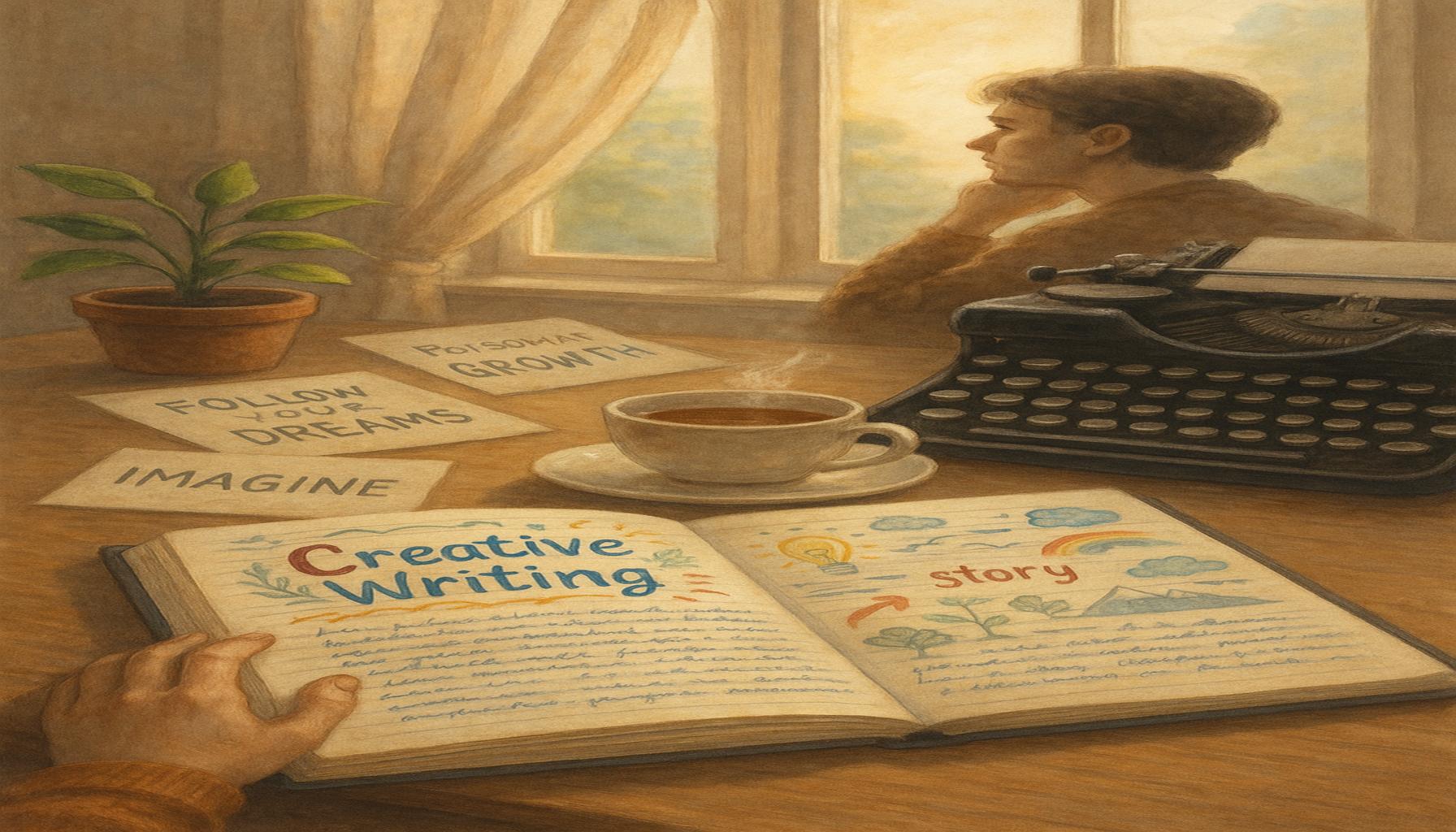The Art of Creative Writing: How to Transform Ideas into Captivating Narratives

Unpacking the Elements of Creative Writing
Creative writing is more than just putting words on a page; it is an art form that allows individuals to express their thoughts, emotions, and visions. Every story begins with a spark of inspiration, but transforming that inspiration into a captivating narrative is where the true craftsmanship lies.
At the heart of creative writing is the writer’s imagination. Imagination fuels creativity, providing a canvas where ideas can flourish without the constraints of reality. Great authors like J.K. Rowling, for instance, conjured the magical world of Hogwarts from a dream. This vivid imagination not only produces unique plots but also enables writers to explore complex themes and emotions.
However, without a keen sense of structure, even the most imaginative ideas may falter. A well-organized narrative is crucial for maintaining reader engagement and ensuring that the story unfolds in a coherent manner. Techniques such as the three-act structure or the hero’s journey are commonly employed by writers to guide their narratives, keeping audiences hooked from start to finish. For example, the movie “Star Wars” follows this classic format, making it an enduring piece of cinema that resonates with diverse audiences.
Character Development is another essential component; relatable characters breathe life into any story. Readers invest emotionally in characters who feel real and nuanced. Consider the character arc of Elizabeth Bennet from Jane Austen’s “Pride and Prejudice,” whose personal growth and flaws make her a compelling figure that resonates deeply with readers across generations.
The setting of a story also plays a pivotal role. A vivid and immersive environment can enhance the narrative, drawing readers into a world that feels tangible. Whether it’s the bustling streets of New York City or the serene landscapes of rural America, the setting establishes the mood and influences the characters’ actions. For instance, the gritty atmosphere of a post-apocalyptic world can evoke feelings of suspense, while a picturesque countryside can instill a sense of peace.

Finally, a story’s theme serves as its heartbeat. Clear messages resonate with audiences, making stories memorable. Themes like love, loss, and redemption are universal yet can be explored in infinitely unique ways, prompting readers to reflect on their own experiences. Take, for instance, John Steinbeck’s “The Grapes of Wrath,” which encapsulates themes of social justice and human resilience during the Great Depression, provoking thought and discussion even today.
Each of these components plays a pivotal role in crafting tales that captivate and inspire. The beauty of creative writing lies in its ability to transport readers to different worlds, evoke emotions, and provoke thoughts. As writers, understanding and mastering these principles can elevate narrative skills, transforming mere ideas into powerful stories.
Whether you’re a budding author or an experienced writer, the journey through the landscape of creative writing promises to be rewarding. Prepare to uncover the joys of transforming ideas into stories that not only entertain but also resonate with your audience deeply.
DISCOVER MORE: Click here to delve into the impact of music on creativity
Crafting Compelling Characters
At the heart of every compelling narrative lies a cast of characters that resonates with readers. Characters are not just vessels for the story; they are the embodiment of the themes and emotions that writers aspire to convey. To create characters that linger in the minds of readers long after the final page, writers must delve into the intricacies of characterization, which encompasses their personalities, backgrounds, motivations, and arcs.
To begin, effective character development requires an understanding of your characters’ backstories. Where do they come from? What experiences have shaped them into who they are? This foundation adds layers to their personalities, making them relatable and authentic. For instance, consider the complex character of Jay Gatsby in F. Scott Fitzgerald’s “The Great Gatsby.” Gatsby’s lavish lifestyle is intertwined with a past steeped in ambition and heartbreak, highlighting the dichotomy of the American Dream.
Moreover, flaws are essential in creating realistic characters. Flaws add depth, allowing readers to see the humanity in characters. A character who is overly proud may struggle with their relationships, while one with insecurities could experience significant growth. Think of Holden Caulfield, the protagonist of J.D. Salinger’s “The Catcher in the Rye.” His cynicism and alienation invite readers to understand his struggles with identity and belonging.
To make characters compelling, writers should also consider their motivations. What drives them to act? Understanding a character’s desires can significantly enhance the narrative tension. Writers can use a simple framework to analyze character motivation:
- Goal: What does the character want to achieve?
- Conflict: What obstacles are in the way of achieving this goal?
- Growth: How does the character evolve throughout the story?
Writers can utilize these elements to construct character arcs that mirror their journeys, providing readers with a sense of progression and fulfillment. For example, in Harper Lee’s “To Kill a Mockingbird,” Scout Finch’s growth from innocence to a more profound understanding of her community and humanity encapsulates a quintessential coming-of-age story.
In addition, creating a diverse cast of supporting characters enriches the narrative fabric. Each character can serve a distinct purpose, whether as a mentor, antagonist, or ally, contributing to the protagonist’s journey. Relationships among characters can create complex dynamics that add tension and depth, engaging readers further. Look at the relationship between Elizabeth Bennet and Mr. Darcy; their evolving interactions are pivotal to the plot and mirror the overarching theme of personal growth.
Ultimately, the art of creative writing lies in the ability to create memorable characters. Readers are not merely looking for surface-level personas; they crave depth, complexity, and relatability. By thoughtfully constructing characters that reflect the intricacies of human experience, writers can weave narratives that captivate and resonate with audiences, cultivating an emotional connection that lasts.
| Writing Techniques | Benefits |
|---|---|
| Character Development | Enhances engagement by creating relatable and multidimensional characters. |
| Descriptive Language | Vivid imagery captivates readers, immersing them in the narrative experience. |
| Plot Structuring | Creates a coherent and exciting storyline that keeps readers on the edge of their seats. |
| Theme Exploration | Deepens impact by allowing readers to connect with broader ideas and morals. |
Expanding upon these key techniques plays a crucial role in honing one’s ability to craft narratives that don’t just tell a story but also resonate with readers on a personal level. Character development, when executed thoughtfully, allows the audience to empathize with struggles and aspirations, breathing life into pages. By employing descriptive language, writers can paint scenes that linger in the imagination long after the final word is read; this is not merely about aesthetics; it’s about **inviting** the reader to dwell within the crafted world.In terms of plot structuring, understanding the nuances of pacing can be transformative. The balance of tension and release keeps the readers guessing “what happens next?” A well-structured plot can also accentuate surprise elements, enriching the overall narrative experience. Incorporating theme exploration allows aspiring writers to delve into significant, relatable issues, providing substance and relevance to the story. This ultimately elevates the writing beyond mere entertainment, engaging the reader intellectually and emotionally. Each technique interlinks, forming the foundation of a vibrant **narrative landscape**.
DISCOVER: Click here to uncover the creative benefits of music
Weaving Intriguing Plots
Once the foundation of compelling characters is established, the next essential element of creative writing is the construction of a captivating plot. A well-crafted plot serves not only as the backbone of a narrative but also as the vehicle through which characters develop and themes unfold. To create a plot that enthralls readers, writers must consider the core dynamics of storytelling: structure, conflict, and pacing.
The classic narrative arc—comprised of exposition, rising action, climax, falling action, and resolution—provides a framework that guides writers in organizing their stories coherently. The exposition introduces readers to the setting, characters, and initial conflict, setting the stage for the journey ahead. For instance, in George Orwell’s “1984,” the oppressive atmosphere of a dystopian society establishes a chilling backdrop for Winston’s rebellion against an authoritarian regime.
As the story progresses, the rising action intensifies the conflict, presenting challenges that hinder the protagonist’s goals. Effective use of tension keeps readers on the edge of their seats. This can be achieved through unexpected twists or the introduction of subplots that intersect with the main narrative. For example, in Gillian Flynn’s “Gone Girl,” the intertwining lives of Nick and Amy, filled with secrets and revelations, cultivate a suspenseful atmosphere that classic thrillers rely upon.
The climax represents the turning point, where tensions reach their peak. This pivotal moment is crucial, as it is the culmination of the character’s struggles and decisions. A gratifying climax not only provides resolution to the conflict but also fulfills the promises set up throughout the narrative. Afterward, the falling action allows for the unraveling of the plot, demonstrating the aftermath of the climax’s events, which paves the way for the resolution, where loose ends are tied up and characters’ arcs reach their conclusion.
Another essential element in crafting a compelling plot is establishing conflict. Conflict can take various forms—internal, external, or relational—each shaping the narrative’s direction and character development. Internal conflicts happen within a character’s mind, reflecting their struggles with personal dilemmas, while external conflicts can arise from societal pressures, antagonistic forces, or physical challenges. In “The Road” by Cormac McCarthy, the profound conflict between survival and morality is evident as the father and son navigate a post-apocalyptic world, prompting readers to reflect on the broader human condition.
Moreover, pacing plays a vital role in maintaining reader engagement. A well-paced narrative balances moments of tension with quieter passages that allow readers to breathe and reflect. For example, in Stephen King’s “The Shining,” the gradual buildup of dread contrasted with periods of calm evokes a chilling sense of unease, immersing readers deeper into the storyline.
Beyond these structural elements, writers can enrich their plots through thematic depth. Themes can be woven into the fabric of the narrative, revealing key messages and resonating with readers on a profound level. Through persistent exploration of ethical dilemmas, societal issues, or the intricacies of love, writers can elevate their stories from mere entertainment to thought-provoking experiences.
By deftly weaving these components of plot—structure, conflict, and pacing—writers engage readers, drawing them into a world that feels both real and emotionally resonant. The art of creative writing thus thrives on the ability to transform ideas into dynamic narratives that leave a lasting impression, prompting readers to dive deeper into the realms of imagination. Through careful construction and an understanding of narrative techniques, writers can captivate audiences and invite them to explore the complexities of the human experience.
DISCOVER MORE: Click here to dive deeper
Conclusion: Embracing the Journey of Creative Writing
In the realm of creative writing, the transformation of ideas into captivating narratives is akin to crafting a masterpiece from a block of marble. It requires patience, skill, and a profound understanding of both structure and emotion. The art of storytelling hinges on the successful interplay of characterization, plot, and theme, which together create an immersive experience for readers. By fostering relatable characters, writers can draw audiences into their worlds, encouraging emotional investment. Moreover, when plots are carefully woven with conflicts and enriched by thematic depth, they invite readers to ponder on life’s complexities long after the last page is turned.
As writers embark on this creative journey, it is crucial to remember that the process itself is as important as the end product. Embracing experimentation, welcoming feedback, and allowing oneself to evolve are indispensable steps in honing one’s craft. Whether through attending workshops, joining writing groups, or simply reading widely across genres, aspiring writers take essential strides toward enhancing their narrative skills.
Ultimately, the essence of creative writing lies in the ability to explore uncharted territories of imagination while articulating them in a way that resonates with others. As one delves deeper into the intricacies of storytelling, it becomes evident that the journey of transforming ideas into captivating narratives is a lifelong adventure filled with continuous learning and exploration. By engaging with the power of words, writers not only create stories but also forge connections—bridging the gap between the writer’s mind and the reader’s heart.


